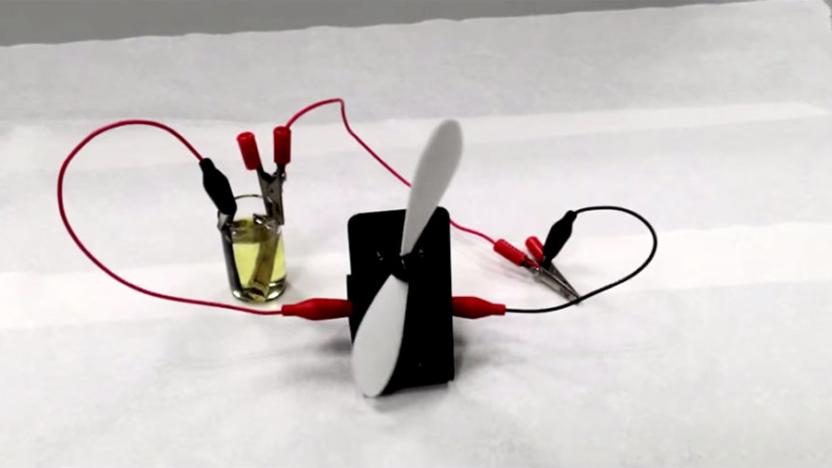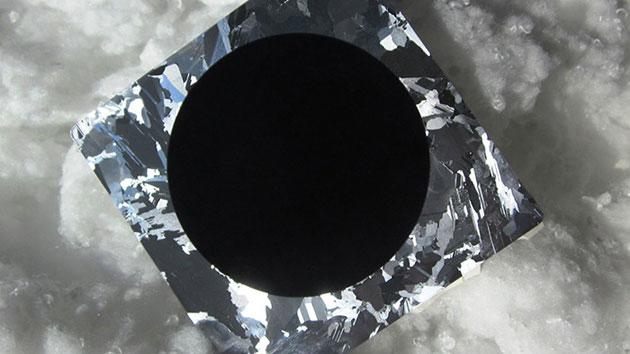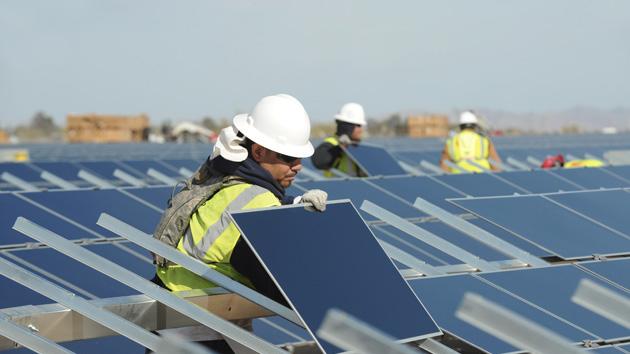power
Latest

GE's robotic inspector dives in nuclear containment vessels
Normally when workers at the Edwin Irby Hatch Power Plant in Georgia want to inspect welds on the water-filled containment tank that houses the plant's nuclear fuel, they have stick pole-mounted inspection cameras in there while potentially exposing themselves to radiation. But now that the plant has acquired a swimming inspection-bot developed by GE and Hitachi, plant workers can check the vessel's integrity at any time while avoiding all that radiation.

Google's making it easy for you to get solar panels onto your roof
Adding solar panels to your roof can be frustrating, since it's often difficult to know if your home receives enough light to justify the investment. Google Maps, however, has satellite, navigation and sunlight data for every property in the world, so it's ideally placed to tell you how many rays hit your crib on a daily basis. That's why the firm is launching Sunroof, a database of how much solar energy hits each building in a city, helping people work out if it's worth the effort. Sunroof is intended as a "treasure map" for future green energy projects, telling you how much of a saving you'd make and how long it'd take to make back your initial outlay.

Solar Impulse delay may end dreams of cross-Atlantic flight in 2015
It's no longer safe to say that the Solar Impulse 2 aircraft will make it around the world before 2015 draws to a close. The crew is now warning that its sun-powered machine won't fly the next leg of its journey (from Hawaii to Arizona) for at least two to three weeks due to severe heat-related battery damage. While that's not the biggest setback the team could face, it could trigger a domino effect. If SI2 doesn't get to the Eastern side of the US in time, it may miss the weather window it needs to get across the Atlantic this year. You'll find out more about the extent of the problem in the next few days, so it should soon be clear whether this is just a momentary obstacle or a serious showstopper.

Light-based battery makes its own power
Sure, you can make solar-powered devices that store their excess energy in a battery, but what about the battery itself? Unfortunately, it's still behind the times -- the lithium-ion cells you see today have to be connected to another device to charge, and they're occasionally very dangerous thanks to their chemical makeup. A team of Indian researchers may have just licked those problems, though. They've developed a battery whose titanium nitrate anode (where current flows into the device) is driven by light, both natural and artificial. In a well-lit area, a prototype can recharge itself without using either an external source or unstable chemicals.

Nissan turns old electric car batteries into fixed energy storage
Mercedes and Tesla aren't the only electric car makers giving their batteries something to do besides getting you from A to B. Nissan is teaming up with Green Charge Networks to repurpose "second-life" (read: used) batteries from Leaf EVs as commercial energy storage. Much like the batteries you can buy for your home, the lithium-ion packs will help offices save money (and ideally, the environment) by storing cheap energy. Companies can charge up overnight to avoid painful peak electricity rates, for instance, or reserve power from solar and wind farms that would otherwise go to waste. The Leaf-based tech will see its first use at one of Nissan's own facilities this summer, but we'd expect it to spread to other businesses in short order.

Mercedes-Benz takes on Tesla with a home battery of its own
Guess what, Tesla: you're not the only car maker getting into the home battery game. Mercedes-Benz has unveiled a personal energy cell that, like Tesla's Powerwall, uses giant batteries to store surplus power from your home's solar panels and keep you off the conventional energy grid. The German firm is taking a more modular approach than its American counterpart, though. Each pack only holds 2.5kWh of electricity, but you can combine up to eight of them to hold 20kWh, or twice as much as a Powerwall. That potentially suits it to certain businesses, not just your own abode. Whatever you think of Mercedes' pack, it may be your best hope of getting some clean energy storage in the near future. With Tesla's unit already sold out through mid-2016, you may have little choice but to register for the Mercedes equivalent and wait until it ships in September.

GE's big-nosed wind turbine generates more power
Despite their giant blades, most wind turbines waste a lot of energy -- gusts around the rotor don't really generate electricity at all. GE thinks it can do better, however. Its experimental ecoROTR turbine touts a big, rotating aluminum nose that sends wind directly toward the blades, where it's more effective. The current design boosts the power output by a modest 3 percent, but that could matter a lot in a large wind farm. The big deal may be what comes next. EcoROTR allows for bigger rotors without having to use larger, harder-to-transport blades. If it ventures beyond the prototype stage, you could see more wind farms in remote locations that both produce more power and keep giant, noisy towers away from your neighborhood.

Solar Impulse begins its sun-powered flight across the Pacific (update: bad weather)
Solar Impulse has already shown the potential for sun-based aviation in its attempt to fly around the world, but it just embarked on its most ambitious trip yet. Pilot Andre Borschberg has taken off from Nanjing, China on a cross-Pacific flight whose first leg ends in Kalaeloa, Hawaii -- 5,061 miles away. That's about 120 hours in the air, and should set records for both the longest single-seat flight ever as well as the first transpacific flight by a solar-powered aircraft. And did we mention that this leg is even more dangerous than previous parts of the journey? After a certain point, Borschberg's only choice in an emergency will be to bail over the Pacific and hope that his rescue goes smoothly.

Super-efficient solar cells can power homes in unforgiving areas
Scientists have long talked about black silicon (that is, silicon with nano-sized structures) having the potential to trump conventional solar power, and there's now some proof that this is happening. Aalto University researchers have developed black silicon solar cells that achieve a record 22.1 percent efficiency when turning the Sun's rays into usable energy. That's a 4 percent absolute boost over the previous best in black silicon, and good enough that the technology could finally be ready to reach the market and replace existing solar panels. Black silicon is far better suited to collecting sunlight at low angles, which is common in northern regions -- you wouldn't have to live in a sunny, forgiving part of the world to get the most out of clean energy. It should be cheaper, too. So long as these black cells translate well to mass production, you may have an easier time ditching the conventional power grid.

Americans are using more energy, but green tech is softening the blow
It may be tough to satisfy the US' seemingly never-ending thirst for energy, but clean power sources are at least helping to soften the impact. Researchers at the Lawrence Livermore National Laboratory have determined that Americans' energy use climbed 1 percent year-over-year in 2014, but its carbon emissions hardly budged at all. In fact, they were down significantly for coal and petroleum-based power. While some of that decline is due to industry using less-than-clean natural gas, it's also helped by big jumps in solar and wind energy, which respectively grew by 33 and 8 percent.

Apple Watch diagnostic port: a goldmine for accessory makers
Long before it officially existed, there were rumors that the Apple Watch had disappointing battery life. It wasn't long afterward that we started to hear companies were preparing to build external power packs to compensate. Thankfully, the folks over at Reserve Strap have discovered that you don't have to sacrifice style in favor of usefulness, thanks to the six-pin "diagnostic" port found on the bottom of the watch case. It turns out that the feature doesn't just transmit data, but can receive power at far faster rates than the magnetic inductive charging panel on the underside.

Tesla will reveal a battery for your home at its April event
You don't have to wonder any longer as to what Tesla will unveil at its April 30th event -- the company just spoiled things in advance. In an email to investors, the company states that its shindig will reveal both a previously-teased battery for your home and a "very large," utility-oriented battery. Details aren't forthcoming (those are for the big show!), but there's a good chance that the hardware will build on the concepts behind existing home batteries, which are often used to store excess solar power and provide backups during outages. The real questions are whether or not Tesla can improve on personal powerplants like it did electric cars, and how much you'll pay versus the competition. You'll likely get the answers to both riddles in just over a week.

Xbox One adds 'energy-saving' option to the set-up process
Anyone who buys a brand new Xbox One will be prompted with a special screen when booting up the console for the first time: A choice between "instant-on" and "energy-saving" power modes. The default in the US is instant-on, which enables updates and content downloads while the console isn't in use, and lets users yell at their Xbox Ones to turn them on. The energy-saving mode consumes less power and can save players an average of $6 to $15 per year in the US, Microsoft says. This isn't a new mode, but the move to offer power choices up front follows a March blog post from the Natural Resources Defense Council that was critical of the Xbox One's always-on default.

What's on your HDTV: 'Powers', 'The Breakfast Club' Blu-ray, 'The Jinx'
Sony's first TV show for the PlayStation Network is finally here. The supernatural cop show Powers will be free for PlayStation Plus members, but everyone can check out the first episode and it's embedded after the break. This week The Breakfast Club is back on Blu-ray for its 30th Anniversary Edition, and HBO wraps up its excellent series looking into the life of creepy killer billionaire Robert Durst. On Sunday, ESPN's 30 for 30 featuring Christian Laettner airs, and we have the season finale of Episodes. Need one more thing to look forward to? Fine, don't forget that Community comes back on Yahoo Screen next week, and of course, the F1 season kicks off Sunday morning from Australia. Look after the break to check out each day's highlights, including trailers and let us know what you think (or what we missed).

UK to build the world's first tidal lagoon power plants
It's easy to forget that it's possible to generate electricity not by burning coal or splitting atoms, but using the power of the sea. One company has thought long and hard about the process and is set to change the way Britain generates its renewable energy. Under new plans, Tidal Lagoon Power hopes to build the world's first lagoon power plants, creating six giant structures -- four of which will be built in Wales, with two in England -- that will harness powerful coastal tides and generate as much as 8 percent of the UK's total power.

The Apple Watch has a low-power mode that only tells the time
If you're jonesing for an Apple Watch, you probably want to do a lot with it. But what if you're headed out to a party and would rather not risk staring at a dead screen when you're wondering how late it is? Don't worry, you're covered. The New York Times understands that the Watch has an unannounced Power Reserve option that limits the device to telling time. While it's not a completely unique feature (other watches do similar things), it's definitely helpful -- and it's a departure for Apple, whose mobile devices haven't had these kinds of extreme energy-saving modes until now. Tim Cook and crew aren't likely to make a big deal of Power Reserve at Apple's March 9th event, assuming it shows up, but it could be one of the Watch's most important real-world features.

Apple invests in a solar farm that can power 60,000 homes
Apple makes much ado about using clean energy sources to power its buildings these days, and it just put its money where its mouth is... a lot of money. The company is investing a whopping $848 million in a First Solar plant in California's Monterey County that, according to Apple chief Tim Cook, should generate enough electricity to power 60,000 homes. Apple will get a 130-megawatt supply from the solar farm to light up buildings such as its future spaceship-like campus, while the remaining 150 megawatts will go to Pacific Gas & Energy's grid. Reportedly, this is the largest commercial deal to date in the solar industry -- it certainly eclipses many of the other green energy initiatives we've seen in tech, which tend to "only" require tens of megawatts.

Super-thin Kevlar layers promise safer, slimmer batteries
Scientists have spent a lot of time trying to lengthen battery life, but safety and thickness matter, too. Just ask Boeing about that first problem -- its 787 Dreamliner was grounded for months thanks to battery fires. However, a group of University of Michigan researchers may have found a way to make lithium-ion energy packs that are safer and slimmer at the same time. The team has developed Kevlar-based, nano-sized membranes that insulate the electrodes in a battery while still allowing lithium ions to pass through and create a proper circuit. The extra-thin layers should not only reduce the chances of short circuiting, but allow for more energy in a given space. You could get away with thinner batteries in smartwatches and other devices without giving up battery life... or worrying that your device will spontaneously combust, for that matter.

How much would you pay for a smart, safe home power outlet?
That is indeed the question, especially considering how inexpensive a standard, non-smart, non-"safe" power outlet is. This nice one from Home Depot costs under $10! What the outlet from Home Depot won't do for you, however, is tell you via smartphone app if it's being used, or which outlets in your house are being used. And it certainly won't kill the power when you're not using it; power outlets, sadly, may be constantly drawing power. If you've got anything plugged in to your standard outlet, even if it's not on, it might still be drawing power. That's both extremely inefficient and a waste of money. There's a company at CES 2015 that's aiming to change that, but what should it charge? Should it even make a "smart" power outlet, or just focus on the "safe" angle? That's still up in the air, but what it's got so far is worth knowing about.

Your old laptop's battery will light homes in developing countries
Don't be too quick to toss out the battery from that ancient laptop -- it might just be the key to powering homes in developing countries, and helping the environment in the process. IBM researchers have revealed UrJar, a device that turns old lithium-ion battery packs into rechargeable energy sources for low-power devices like LED light bulbs, fans and cellphones. To create the gadget, the team extracts functioning lithium-ion cells from a trashed battery and combines them with both charging dongles and safety circuitry. It sounds simple, but it's potentially very effective. According to IBM, roughly 70 percent of all discarded batteries can provide at least four hours of LED lighting every day for a year. That's enough to offer extra safety to homes in areas with little to no reliable electricity, or to keep a street vendor in business after sunset.






